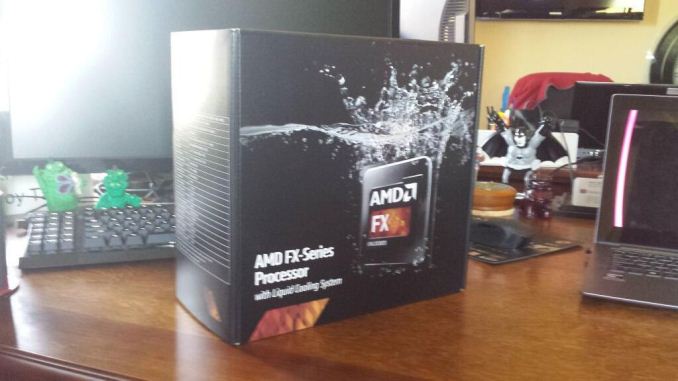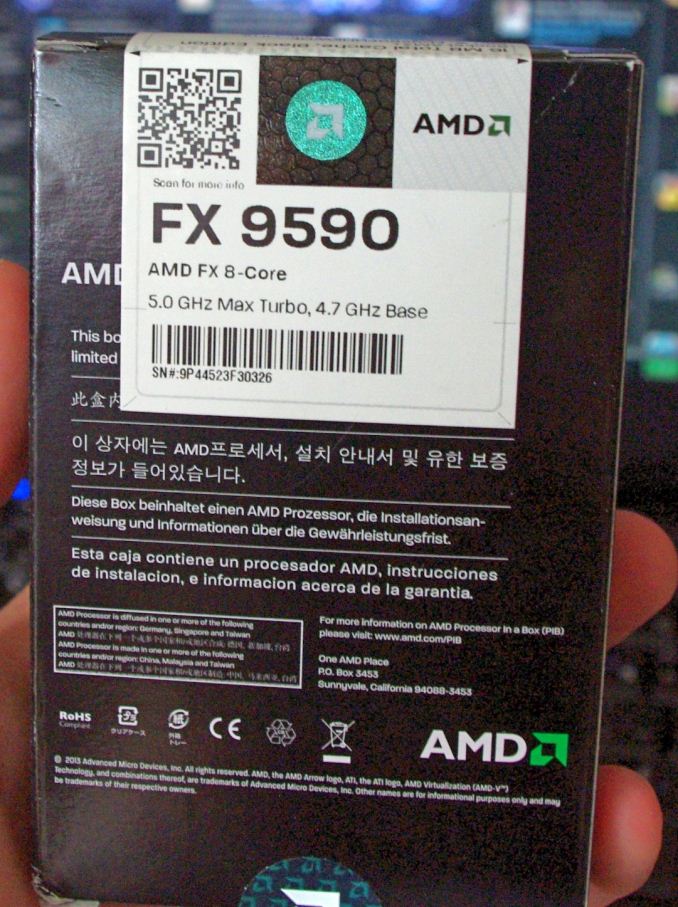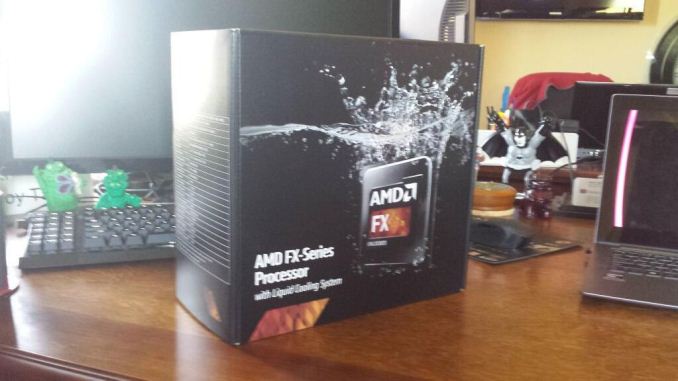AMD’s 5 GHz Turbo CPU in Retail: The FX-9590 and ASRock 990FX Extreme9 Review
by Ian Cutress on August 9, 2014 8:00 AM EST
While AMD’s FX-9590 CPU has been in systems for over a year, it suddenly comes to market as a retail package for end-users to buy with a bundled liquid cooling system. This 220W CPU that has a turbo speed of 5.0 GHz still sits at the top of AMD’s performance stack, despite subsequent improvements in the architecture since. We have decided to grab ASRock’s 990FX Extreme9 and an FX-9590 for a review to see if it still is the AMD performance CPU champion.
Spot the CPU
The story behind AMD’s fastest ever x86 CPUs is slightly odd. Two models, the FX-9590 and FX-9370, were both launched into OEM channels in June 2013. Being an OEM component, the only way to get one was in a pre-built system through a retailer, or through a bulk system integrator that had a model around one of these CPUs. Typically this is a process that is only exhibited with server class processors: from a range of CPUs being produced, only several will be available for end-users at retail because server CPUs usually go through a system builder. At the time, it seemed that AMD concerned that the high TDP of this CPU, at 220W listed, is too much for most cooling setups within a home user system and the best way to get it to consumers would be if a system builder chose the appropriate cooling for them.
As a result of this orientation of sales, AMD did not sample the media with review units. We review an AMD product typically though an AMD sourced sample. It was also noted that the OEM price for the CPU was near $900 for the FX-9590, which seemed like an excruciating amount for what was essentially a good overclocking version of the FX-8350. Several media websites were able to collaborate with system builders in order to get a chance to review the CPU, and AMD was confident in their promotion and handling of the new CPU.
Anecdotally, in my field of vision, the promotion of this CPU was relatively limited. The price was the main factor, resulting in comparative AMD/Intel systems being more power hungry on the AMD side, and substantially more expensive when put up against the latest mainstream i7 at the time. As a result, while some retailers were selling the OEM CPU at full price, some retailers decided to sell their OEM stock with a severe price cut directly to consumers, down from $900 to $390, in order to get rid of units (this is when I picked up our sample).
Due to the OEM nature of these sales to end-users, each CPU had either no warranty with AMD or a limited warranty. For the user interested in a 3-year system cycle without the fear of a bad egg, the OEM route is never a positive one.
AMD subsequently released, relatively silently, a proper package and retail version of the FX processors. It was apparent that this was in response to the OEM sales, with the retailers list ‘heatsink and fan not included’ alongside the specifications.
| AMD FX CPU Comparison | ||||||
|
FX- 4350 |
FX- 6350 |
FX- 8320 |
FX- 8350 |
FX- 9370 |
FX- 9590 |
|
| Release Date |
April 2013 |
October 2012 | October 2012 | October 2012 | June 2013 | June 2013 |
| Modules | 2 | 3 | 4 | |||
| L1 Cache (Code) | 128 KB | 192 KB | 256 KB | |||
| L1 Cache (Data) | 64 KB | 96 KB | 128 KB | |||
| L2 Cache | 4 MB | 6 MB | 8 MB | |||
| L3 Cache | 8 MB | |||||
| TDP | 125W | 220 W | ||||
| Base Frequency | 4200 | 3900 | 3500 | 4000 | 4400 | 4700 |
| Turbo Frequency | 4300 | 4200 | 4000 | 4200 | 4700 | 5000 |
| Core Name | Vishera | |||||
| Microarchitecture | Piledriver | |||||
| Socket | AM3+ | |||||
| Memory Support | DDR3-1866 | |||||
| Price (US) | $140 | $140 | $160 | $190 |
$230 $300 CLC |
$300 $370 CLC |
Since that release, AMD has not upgraded their enthusiast processor line with the latest architecture. The FX line has stayed where it is, perhaps for a number of reasons. One could speculate that releasing the next generation of FX-85xx might put them behind the FX-9590 in performance, or that the fabrication process was not suitable for a quad-module CPU with the new architecture improvements. The FX line for desktops, as far as we know, is staying at 32nm with no improvements.
Now Available
Fast forward twelve months to June 20th 2014 and Roy Taylor, AMD’s VP of Global Channel Sales tweets this innocuous picture:
Speculation was rife as to what this was. Here is a large box for an FX processor with the words ‘with Liquid Cooling System’ underneath. AMD supplied liquid cooling to the media when we reviewed the FX-8350 CPUs, the main CPU that sits underneath the FX-9590 and FX-9370, so there was an expectation that was something new.
On June 26th, the @AMDFX twitter account posted the following, confirming that this was the older FX-9590 but in a retail box with retail cooling:
To celebrate the start of ‘Round of 16’, we’re giving away eleven FX-9590 CPUs! #FXCUP pic.twitter.com/21JRaHdMq8 — AMD FX (@AMDFX) June 26, 2014
The AMD FX Processor page has been updated accordingly, showing the same render of the new box. Here we see that the liquid cooler is supplied by Cooler Master, and uses a wide range PWM fan as part of the package.
Of course, this leaves several questions unanswered: how much, when is it on sale, where is it on sale, and is it still any good? Well for the US at least, it is on sale today from Newegg at $370 with the water cooling kit, or $330 without. NCIX has it listed for CAD$500, although this is currently in ‘back stock’ mode.
The SKU to look for is the FD9590FHHKWOX, which in the UK does not seem to be on the shelves as of yet. Amusingly, when this is typed in to Google, the search engine asked me if I meant FD9590FHHKWOF, the non-CLC version.
This Review
Back when the FX-9590 was originally released alongside the FX-9370, we were unable to secure a sample from AMD and the limited availability made us feel the CPU had a fairly limited scope for testing. However, now the landscape has changed. There has been no new FX CPUs on the market from AMD, and this subsequent release of a retail version piques the interest as to how relevant AMD still sees their high-frequency part. Because I now have a FX-9590 all of my own to test from when the OEM stock was sold, I felt it was worth revisiting to see if it can be considered an investment.
Alongside testing this CPU, the 220W TDP requires a substantial motherboard to match. Due to the age of the platform, the AM3+ socket and the old 990FX chipset, finding a motherboard can be rather tricky. Many of the AM3+ motherboards that were launched were only suited for the FX-8350 processors, which had a 125W TDP. This is yet another reason that AMD wanted the FX-9590 in the hands of system builders who would chose high end motherboards that could cope.
Two of the newest motherboards to be released for 990FX were the ASRock 990FX Killer and the ASRock 990FX Extreme9. We reported the release of the Killer in December 2013, but the Killer is unsuitable here as the specification sheet lists processors up to 125W only. The Extreme9 is ASRock’s high-end AM3+ motherboard, and more suited to the task. Luckily I had requested a sample almost a year ago for some regression testing, so we will be reviewing this motherboard as part of this article.














146 Comments
View All Comments
just4U - Sunday, August 10, 2014 - link
In my opinion the best cpu AMD has right now is A8 7600 coming in at $120 CAD. I see no reason to go Intel i3 as long as that puppy is there. (A argument can be made for Intel's AE 3x) The downside for AMD is I also see no reason why anyone should buy a more expensive CPU/APU from them.. their A-10 is priced in the same range as lower I5's which is a bit of a head shaker and their AM3+ is getting long in the tooth with no refresh.I could see a new FM2+ FX branded cpu priced at the tier their offering their A-10s for as it would bring something more to the table.. but they do really have to do something about single threaded performance. Even if it wasn't being used as much in programs their line-up takes a beating in reviews which is bad optics for them and leads to people like us (who read these things..) to suggest other alternatives for people buying/building a system.
FightApathy - Sunday, August 10, 2014 - link
237W operational power consumption. This is just.... terrible for a 2014 CPU. And what is even worse, is that i7 with 1/3 of TDP performs as well or even better. AMD has to stick to APUs.KAlmquist - Sunday, August 10, 2014 - link
"One could speculate that releasing the next generation of FX-85xx might put them behind the FX-9590 in performance, or that the fabrication process was not suitable for a quad-module CPU with the new architecture improvements."According to the Steamroller review, the 28nm bulk process that Steamroller was designed for won't clock as high as the 32nm SOI process that Piledriver uses. So an 8 core Steamroller processor would execute more instructions per clock, but would be clocked at least 400 Mhz slower, and as a result would be only marginally faster than Piledriver.
AMD is expecting to achieve another boost in instructions per clock with Excavator, but unless something has changed they plan to synthesize Excavator using software that minimizes die area at the cost of clock speed, so I'd expect Excavator to do more to improve performance per watt than to improve absolute performance.
After Excavator comes a completely new design, which we can hope will be a major improvement over the bulldozer derivatives.
mathewmichal7 - Sunday, August 10, 2014 - link
Draft your credit agreement is an excellent example of an innovative style of marketing. There is a provision for the lender to get cash advance check their debtors. He takes comfort in check on the day of your salary. Undoubtedly reduces the possibility of non-payment money and is beneficial for the creditor and the debtor. Delinquent and insolvent are not left disappointed by the money lenders. Your loan application forms become a matter of serious consideration if they manage to impress your money lenders for their current financial situation. The number of your credit profile does not control the situation and creditor left unchecked.http://www.12monthloansmoney.co.uk
duploxxx - Monday, August 11, 2014 - link
funny to read all these replies. makes you wonder what avarage age and technology knowledge is of these tech sites.....All complaining about useless AMD and process tech but yet they don't understand that these own consumers are the ones to blame, they buy the jingle and bells and the marketing buzz... recent review on anandtech showed enough what was best to buy, yet most decide to buy the other marketing dominant brand as if there all day tasks are faster since the benchmarks show few percentage faster finished task... buyers need to blame themselve for there own stupid decisions. Want a fast system? get rid of Microsoft garbage. OEM-marketing kill the competition and consumers are the victim but they still dont understand it. (useless chipset revisions, socket changes, design rules like in ultrabook space and centrino, etc, etc..). poor consumers.
From a tech site you indeed need to review such a CPU, its mandatory but i don't think it gets the honor for what it supposed to be, anyhow there will be only few to sell since it has no reason to exist becide the mythical part.
I remember the days of pentium D and extreme, no reason at all to exist yet 1000's of buyers just for the brand....
duploxxx - Monday, August 11, 2014 - link
since no edit button :) thx anandtech asking that already for more then 10yI meant age and knowledge of the readers of course
Klimax - Monday, August 11, 2014 - link
Lovely nonsensical post. Including out of date bashing of Microsoft. 90s called, they want your nonsense back.Mugur - Monday, August 11, 2014 - link
There is still room for AMD in my home. I have 2 SB Core i3s for the gaming machines and I've just replaced an 80W Phenom II HTPC with an Intel NUC 2820. But my server (currently an Athlon II X4) will be soon an A10-7800 at 45W on a FM2+ with 8 SATA board...jgarcows - Monday, August 11, 2014 - link
How did you manage to post a review of a chip with a bundled retail liquid cooling system and not post a single picture of the liquid cooling system? How easy was it to install, what size openings are needed on the case, etc...LemmingOverlord - Monday, August 11, 2014 - link
May I suggest:a) some impressions on the liquid cooling? (+pics)
b) underclocking the CPU (and lowering voltage), then map that to power v. performance curves for the same set of benchmarks you ran... just to see how big a drop it would be in wattage.